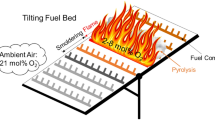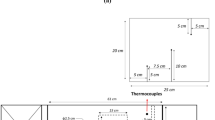Abstract
Despite the fact that liquid fuel spills present a potential fire hazard in numerous industrial and residential settings there has been minimal research conducted to understand the spill and burning dynamics of these types of scenarios (Gottuk et al., NRL/MR/6180-00-8457, 2001; Putorti, NIJ-604-00, 2001; Mealy et al., NIJ-2008-DN-BX-K168, 2010; Ma et al., Fire Technol 40:227–246, 2004). While the findings of these studies were significant in that they demonstrated a substantial decrease in the peak fire size achieved in spill fire scenarios compared to pool fires, the empirical data sets collected were not sufficient to fully understand the phenomena causing this reduction. In general, both studies attributed the decrease to thermal losses to the substrate but indicated that further investigation was required. In order to address this general lack of empirical data, a research program was conducted to characterize fuel spill fire dynamics with respect to the key variables that potentially impact these types of fires. A discussion of the test results is presented in two parts: the first being the development of a liquid spill, specifically spill depths and spill progression, and the second being fuel burning dynamics, specifically the impacts of substrate, ignition delay, and substrate temperature. The development of a spill and the associated liquid depths are described for various fuels and fuel simulants, whose properties provide bounding spill scenarios for most fuels of interest. The burning dynamics of various fuel spill scenarios are evaluated relative to numerous substrates, ignition delay times ranging from 30 s to 300 s, and substrate temperatures ranging from 12°C to 38°C (54°F to 100°F). The impact of these variables was evaluated relative to the heat release and mass burning rates measured during these tests.





Similar content being viewed by others
References
Gottuk D, Scheffey J, Williams F, Gott J, Tabet R (2001) Optical fire detection for military aircraft hangars: final report on OFD performance to fuel spill fires and optical stresses. Naval Research Laboratory, NRL/MR/6180000-8457
Putorti A (2001) Flammable and combustible liquid spill burn patterns. National Institute of Justice, NIJ-604-00
Mealy C, Benfer M, Gottuk D (2010) Fire dynamics and forensic analysis of liquid fuel fires, NIJ-2008-DN-BX-K168
Mealy C, Benfer M, Gottuk D (2011) A study of the parameters influencing liquid fuel burning rates. In: Fire safety science—proceedings of the 10th international symposium, international association of fire safety science, University of Maryland, College Park, MD, June 19–24
Burgess D, Zebatakis M (1960) Research on the hazards associated with the production and handling of liquid nitrogen. Bureau of Mines, Department of the Interior, WADD TR 60-141
Gottuk D, White D (2008) Liquid fuel fire. In: SFPE handbook for fire protection engineering, Section 2-15. Society of Fire Protection Engineers, pp 2–297
Raj K, Phani P, Kelelkar A (1974) Assessment models in support of hazard assessment handbook. Department of Transportation, 74685-40
Grimaz S, Allen S, Stewart J, Docetti G (2997) Predictive evaluation of surface spreading extent for the case of accidental spillage of oil on the ground
Ma T, Olenick S, Klassen M, Roby R, Torrero J (2004) Burning rate of liquid fuel on carpet (porous media). Fire Technol 40:227–246
Acknowledgements
This project was supported by Award No. 2008-DN-BX-K168 awarded by the National Institute of Justice, Office of Justice Programs, U.S. Department of Justice. The opinions, findings, and conclusions or recommendations expressed in this publication/program/exhibition are those of the author(s) and do not necessarily reflect those of the Department of Justice.
Author information
Authors and Affiliations
Corresponding author
Rights and permissions
About this article
Cite this article
Mealy, C., Benfer, M. & Gottuk, D. Liquid Fuel Spill Fire Dynamics. Fire Technol 50, 419–436 (2014). https://doi.org/10.1007/s10694-012-0281-x
Received:
Accepted:
Published:
Issue Date:
DOI: https://doi.org/10.1007/s10694-012-0281-x




